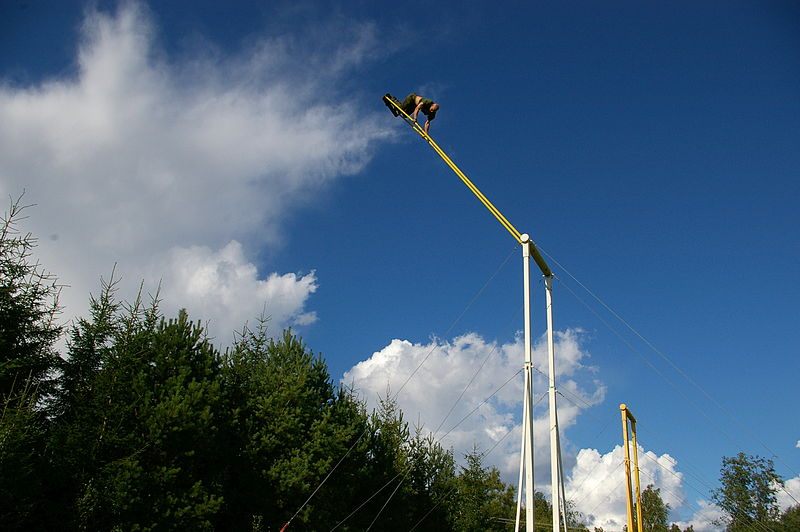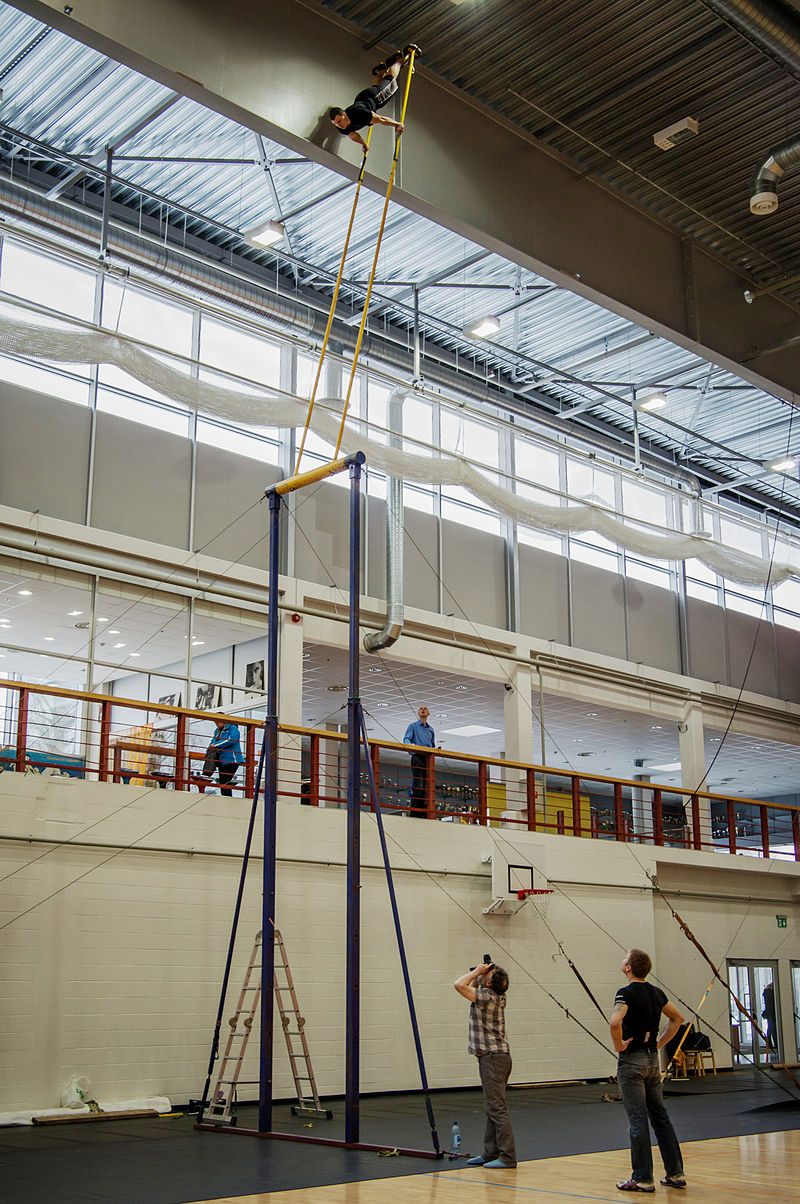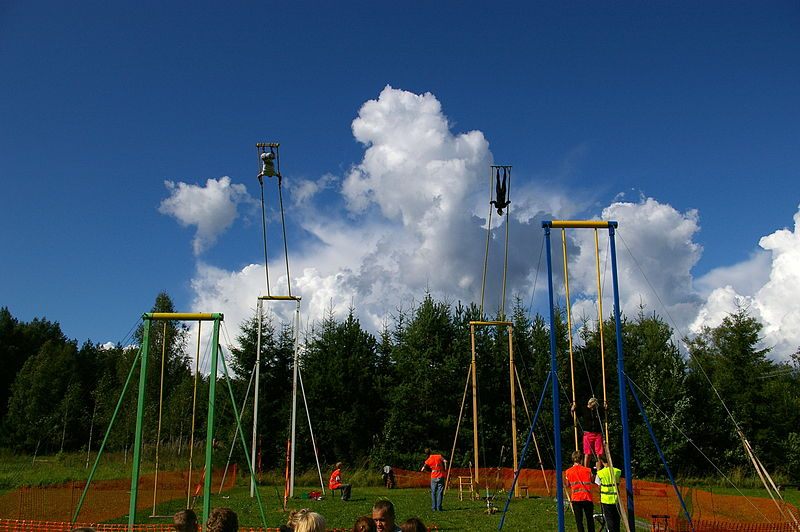Inside the High-Flying World of Estonian Extreme Swinging
Kiiking turns Estonia’s cultural obsession with swings into an X-Games contender.
Every kid who has ever climbed on a swing set has dreamt of swinging so hard that they loop right over the top, impressing everyone in attendance. Of course, often enough, this can lead to busted bones and bruised egos. Meanwhile in Estonia, thanks to a cultural love affair with swings, going over the top has developed into a serious extreme sport.
Kiiking, as the sport of extreme swinging is known (“kiik” is “swing” in Estonian), is fairly young, having first been introduced in the early 1990s, but it has deep roots in Estonia’s cultural past. “Wooden swings are traditionally a big part of Estonian culture and all around Estonia you can find different wooden swings (they are called ‘village swings’) where all the people from surrounding places came together during celebrations or just to have fun while swinging and singing,” says Raili Laansalu, a kiiker since she was just 8 years old, and whose family currently runs the premiere website for the sport, Kiiking.com. To this day, communal wooden swings can be found in towns and villages across the country, so it’s perhaps no wonder that some Estonian daredevil would be the one to invent a way to go over the top.

Sending one of those large village swings 360 degrees around its spindle is possible, but as with any standard swing, people would reliably injure themselves in the effort. Then in 1993, a man named Ado Kosk created a pair of wooden swings for the express purpose of going all the way around. They were simple levers with a pair of wooden rods attached to a flat seat on one end, and swinging spindle at the top. Early proto-kiikers would tie their feet to the seats of Kosk’s swings and thrust their body back and forth to gain momentum until they sent themselves all the way around.
As Laansalu tells it, a man named Tarmo Männigo attempted an arc over the spindle of both of Kosk’s swings. Männigo was able to conquer the first swing, which stood about 2.5 meters tall, but when he attempted to swing around the second, which stood slightly taller, at 2.7 meters tall, he couldn’t quite get over. It became clear that the taller the swing got, the more difficult it would be to complete a circuit over the spindle, which meant that there could be competitive accomplishments, and thus, a new sport was born. “We, who are kiikers so to say, like to say that “kiiking” starts when your legs are higher than your head, before that it is just swinging,” says Laansalu.
By 1997 Kosk had continued to refine his vision of kiiking as a pastime, and he invented a telescoping metal swing that could be raised and lowered safely, to allow for variable skill levels. The design has continued to be refined over the years, and the height of the swings increased. The spindly metal forks and system of support wires of modern kiiking swings are a far cry from Kosk’s original rustic inventions.
It would be a stretch to say that kiiking has become a major sporting event—there is no international tournament or anything more than small local clubs. Even in Estonia, Laansalu says that while most people know a kiiking swing when they see one, even the locals are a bit lost as to the competitive rules.
At least in Estonia, where kiiking is most popular, the rules of competition are regulated by the Estonian Kiiking Association* (Eesti Kiikinguliit). Kiikers set a certain height for the swing that they will then have the chance to try and round using just the momentum from their body. Should they swing all the way around at the stated height, they can try to go higher. “[For example], I set my first height at 4 meters. I make one spindle so I am allowed to choose a new height. For next one I choose 4.20 meters. I also complete that so I choose now 4.50 meters. If I do not complete 4.50m, my end result will be 4.20m,” says Laansalu. The competitor who can flip around the highest swing wins. According to Guinness World Records, the current champion kiiker cleared a 7.15 meter swing in 2015.

Before you assume that just vigorously swinging like an insane school kid will get you over the top, Laansalu says that you’d better be in top physical form if you want to be competitive, citing footballers, rowers, and roller-skaters (because Estonia is delightful) as prime candidates for the sport. It takes a lot of arm and leg strength, as well as solid technique to master the perfect timing of when to stand, when to sit, and when to thrust to complete a 360. This is swinging for the Red Bull set.
Kiiking has gained some popularity outside of Estonia. Small groups and local teams have begun popping up from Germany to the U.S., but it is still considered mostly an Estonian sport. For Laansalu, kiiking has been a part of her life since she was a child. “I started doing kiiking when I was 8 years-old, when my father bought us our first kiiking swing,” she says. She continued competitive kiiking until she was 15, when she stopped competing after moving abroad. Still, she dreams of besting her own kiiking record. “My record until today is 4.83 meters,” she says. “Though, I still secretly hope that one day I will get back to it, like I used to, and I will do my 5 meter!”
*Correction: In a previous version of this article the official organization was named as the Estonian Kiiking Union (Eesti Kiiking Liit), this has been corrected to the Estonian Kiiking Association (Eesti Kiikinguliit).











Follow us on Twitter to get the latest on the world's hidden wonders.
Like us on Facebook to get the latest on the world's hidden wonders.
Follow us on Twitter Like us on Facebook